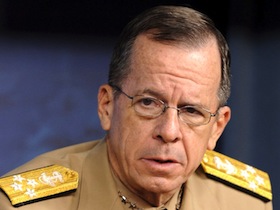Adm. Mullen: Pakistan's Nuclear Weapons Are Safe
July 11, 2011
Featured Image
Today's top nuclear policy stories, with excerpts in bullet form.
Stories we're following today: Monday, July 11, 2011.
Mullen: Pakistani Nuclear Controls Should Avert Any Insider Threat - Elaine Grossman in Global Security Newswire [link]
- The highest ranking U.S. military officer [Adm. Mike Mullen] said on Thursday that Pakistan's control over its nuclear weapons appears tight enough to protect against the possibility of seizure by extremist sympathizers who might infiltrate the nation's army or intelligence service.
- [He] and others have said the Energy Department has invested in helping Islamabad improve its ability to safeguard the Pakistani nuclear stockpile. "We have offered any assistance that Pakistan might desire with respect to [the] means for security of nuclear weapons," James Miller, the principal deputy Defense undersecretary for policy, said.
- Despite the "positive steps" that Pakistan has taken to safeguard its stockpile, there are constraints on how much information the United States has been able to obtain about the South Asian country's nuclear weapons or infrastructure, Mullen acknowledged.
Iran's nuclear threat is escalating - William Hague in The Guardian [link]
- On 8 June, the head of Iran's Atomic Energy Organisation, Fereydoun Abbasi Davani, announced plans to triple Iran's capacity to produce 20% enriched uranium … [which] enriched to up to 20% does have some civilian uses. But not in the civilian nuclear power stations that Iran claims to desire.
- Enrichment from natural uranium to 20% is the most time consuming and resource-intensive step in making the highly enriched uranium required for a nuclear weapon. And when enough 20% enriched uranium is accumulated at the underground facility at Qom, it would take [Iran] only two or three months of additional work to convert this into weapons grade material.
- This is not an abstract issue: Iran's nuclear programme could lead to a nuclear arms race in the Middle East, already the world's most volatile region.
Nuclear Disarmament: the South African Example - Daryl G. Kimball in Arms Control Now [link]
- Do states that have developed nuclear weapons have the vision and the courage to verifiably eliminate their nuclear arsenals? As South Africa has shown, some do.
- July 10 [marked] the 20th anniversary of the Republic of South Africa’s signature of the nuclear Nonproliferation Treaty (NPT) as a non nuclear-weapon state, making it the first and — so far — the only country to build nuclear weapons and then later to voluntarily abandon them.
- The decision by then-president FW de Klerk to wind down the program and join the NPT was shaped in part by South Africa’s apartheid-era isolation, the resolution of its military engagement in Namibia, and the movement toward majority rule.
- The history of South Africa’s nuclear weapons program and the events and decisions that led to its decision to verifiably abandon its arsenal are detailed in a December 1995 article “South Africa’s Nuclear Weapons Program: From Deterrence to Dismantlement” in Arms Control Today by Waldo Stumpf, who was at the time the chief executive officer of the Atomic Energy Corporation of South Africa.
Report: UPF could cost up to $7.5 billion - Frank Munger in Knoxville News Sentinel [link]
- In the latest issue of its three-times-a-year publication, Y-12 Report, the Y-12 nuclear weapons plant devotes most of the space to touting the proposed Uranium Processing Facility … [which] is trumpeted as the "Key to Global Security."
- But what is the price for that global security? According to a new report (not the Y-12 Report), the Oak Ridge project could be even more expensive than the government's most recent cost range of $4.2 billion to $6.5 billion
- Todd Jacobson, in the July 1 issue of Washington-based Nuclear Weapons & Materials Monitor, reported that an independent assessment of the UPF by the Army Corps of Engineers concluded that the cost of the new production facility at Y-12 would be between $6.5 and $7.5 billion.



